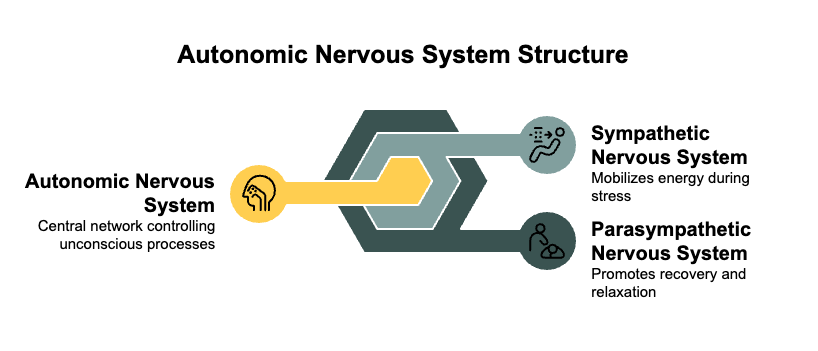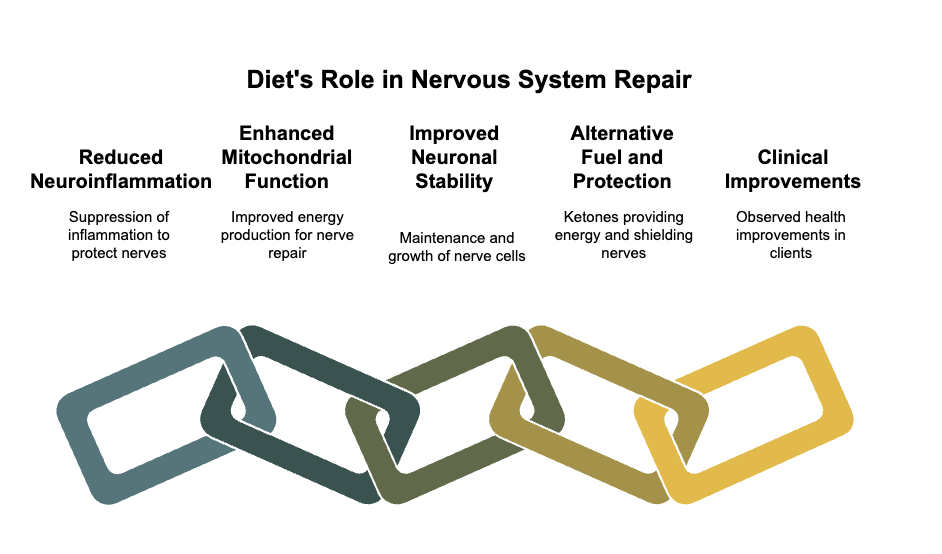
Table of Contents
- Understanding Your Autonomic Nervous System
- Signs Your Autonomic Nervous System Needs Repair
- Common Conditions Related to ANS Imbalance
- Diagnostic Approaches for Assessing ANS Health
- How to Heal The Autonomic Nervous System Through Diet
- The Role of Exercise in Autonomic Nervous System Recovery
- The Role of Neuroplasticity in Healing
- Frequently Asked Questions
- Conclusion: Your Pathway to Autonomic Healing
Understanding Your Autonomic Nervous System
Are you experiencing unexplained symptoms related to your nervous system and you are here because you would like to learn how to repair your autonomic nervous system?
You are not alone. Many clients we work with have seen countless doctors and practitioners, often being dismissed or told it’s ‘all in your head’.
Millions of people are experiencing nervous system dysregulation without clear answers, leaving them frustrated, exhausted and searching for solutions. In fact, a study published in PubMed Central revealed that for those with dysautonomia (an umbrella term encompassing various autonomic nervous system disorders), found that the average duration from symptom onset to diagnosis exceeds 7 years – that is a long time to reach a diagnosis!
At the Integrated Health Foundation, we frequently encounter clients with dysautonomia and nervous system dysregulation who have been overlooked by healthcare providers despite severe symptoms.
Often, the autonomic nervous system (ANS) is the overlooked culprit, and many individuals eventually identify autonomic dysfunction as the root issue after prolonged uncertainty.
So, what is the autonomic nervous system (ANS)?

It has two main branches that should work in harmony:
- Sympathetic Nervous System (SNS): Initiates the “fight-or-flight” response during stress.
- Parasympathetic Nervous System (PNS): Facilitates “rest-and-digest” functions for recovery and relaxation.
When these branches fall out of balance, symptoms often emerge. The next section examines these indicators.
Signs Your ANS Needs Repair
Recognizing the need to repair your autonomic nervous system begins with identifying its distress signals. These are tangible manifestations of ANS imbalance:
- Cardiovascular symptoms: Heart palpitations, fluctuating blood pressure, lightheadedness upon standing (orthostatic intolerance).
- Digestive disturbances: Irritable bowel syndrome (IBS), bloating, constipation, diarrhea, nausea.
- Energy and temperature regulation: Persistent fatigue, excessive or insufficient sweating, sensitivity to temperature changes.
- Sleep disruptions: Insomnia, unrefreshing sleep, night sweats.
- Mood and cognitive challenges: Anxiety, panic attacks, brain fog, difficulty concentrating.
- Pain responses: Heightened pain sensitivity, unexplained muscle discomfort, or headaches.
When these symptoms occur together without an apparent medical explanation, autonomic dysfunction merits consideration. According to the Mayo Clinic, such issues frequently arise when the autonomic nervous system is impaired. Understanding these signs paves the way to identifying related conditions.
Let’s explore some of the diagnosable conditions of nervous system dysregulation.
Common Conditions of ANS Imbalance
Autonomic nervous system dysfunction can lead to diagnosable conditions, many of which our clients at Integrated Health Foundation have faced, often undiagnosed for extended periods:

- POTS (Postural Orthostatic Tachycardia Syndrome): This condition disrupts blood flow regulation, causing rapid heart rate increases upon standing. A Journal of the American Heart Association study estimates it affects 1-3 million Americans.
POTS is defined by a heart rate increase of at least 30 beats per minute within 10 minutes of standing, accompanied by orthostatic intolerance symptoms.
- Dysautonomia: An umbrella term encompassing various autonomic nervous system disorders, ranging from mild to debilitating. It impacts over 70 million people worldwide, occurring independently or secondary to other conditions.
- Autonomic Neuropathy: Characterized by damage to nerves controlling involuntary functions, this affects organs such as the bladder, cardiovascular system, and digestive tract (Mayo Clinic, 2023).
- Chronic Fatigue Syndrome (CFS) and Fibromyalgia: These conditions often involve autonomic dysfunction.
A 2025 study noted significant autonomic nervous system dysfunction in CFS patients, with 45-47% showing extreme blood pressure variability during tilt table testing.
- Long COVID and Post-Viral Syndromes: Emerging evidence shows that COVID-19 and other viral infections can trigger autonomic dysfunction, with 71% of Long COVID patients experiencing moderate to severe issues persisting up to 36 months post-infection
Identifying these conditions is crucial, and we find for many clients we work with that they consult many professionals in the pursuit of finding a diagnosis.
The following section explores diagnostic methods to better understand if the autonomic nervous system has been impaired.
Diagnostic Approaches for Assessing ANS Health

Many individuals with autonomic dysfunction consult numerous physicians without receiving adequate testing. At Integrated Health Foundation, we’ve supported clients through this challenging process. Below are evidence-based tests to evaluate autonomic function:
- Heart Rate Variability (HRV) Testing: This assesses the variation in time between heartbeats, offering insight into ANS balance. Lower HRV suggests stress dominance, while higher HRV indicates relaxation dominance. It is a reliable, non-invasive measure, even with consumer devices (Shaffer & Ginsberg, 2017).
- Tilt Table Testing: This evaluates blood pressure and heart rate responses to positional changes, essential for diagnosing orthostatic intolerance and POTS. Results must be interpreted alongside clinical symptoms (Mayo Clinic, 2023).
- Quantitative Sudomotor Axon Reflex Test (QSART): This test measures sweat gland function, controlled by the sympathetic nervous system, and is highly sensitive for detecting small fiber neuropathy linked to dysautonomia.
- Gastrointestinal Motility Testing: As the ANS governs digestion, this test identifies dysfunction affecting gut movement, with studies showing a strong link to autonomic issues.
- Pupillometry: This examines pupil responses to light, controlled by both ANS branches, and is effective for detecting subtle dysfunction across various conditions.
If symptoms are dismissed without these tests and one is seeking further insights, it is recommended to consult a neurologist specializing in autonomic disorders or a functional medicine practitioner.
At Integrated Health Foundation, our free Symptoms Evaluation Assessment provides a detailed starting point.
With a better understanding of testing in hand, the next step is repair, beginning with dietary strategies.
How to Heal The Autonomic Nervous System Through Diet

The gut-brain axis (GBA) is a two-way communication network between the central and enteric nervous systems which directly influences autonomic function.
Think of the GBA as a two-way highway that connects your brain and your belly. Your brain and stomach constantly send messages to each other to help control things like digestion, mood, and energy. This system works through special chemicals (hormones), your body’s defense system (immune system), and the automatic part of your nerves that control things without you thinking about them (autonomic nervous system). When everything works well, your body feels good, but if something goes wrong, it can affect how you feel in your stomach and even in your mind.
At the Integrated Health Foundation, we’ve seen remarkable improvements in autonomic nervous system (ANS) function by bridging the connection between the brain’s limbic system and gut health through targeted nutrition.
The Ketogenic and Carnivore Approach for Nervous System Healing
Ketosis, achieved through low-carbohydrate diets like ketogenic or carnivore, generates ketone bodies with notable neuroprotective effects.
A systematic review in the Journal of Neurochemistry found that ketosis reduces brain damage, lowers neuron loss, and enhances recovery by reducing oxidative stress and improving energy production. These benefits scale with ketone levels, offering potential for neurological repair.
How Ketosis Supports Autonomic Healing
A ketogenic diet supports autonomic nervous system repair through:
- Reduced neuroinflammation: Ketones, particularly beta-hydroxybutyrate (BHB), suppress inflammation that harms autonomic nerves (Youm et al., 2015).
- Enhanced mitochondrial function: Ketosis improves energy production in nerve cells, aiding repair and regeneration (Jensen et al., 2020).
- Improved neuronal stability: It supports nerve cell maintenance and growth.
- Alternative fuel and protection: Ketones provide a reliable energy source, activating pathways that shield and repair nerves.
Our clients at Integrated Health Foundation who have adopted a ketogenic approach often report reduced fatigue and sharper focus, underscoring its impact on ANS recovery.

Nutrition is a key pillar of our protocol, what you fuel your body with is essential. However, lasting health also requires lifestyle adaptations, like exercise, which works hand in hand with nutrition.
Let’s explore its impact.
The Role of Exercise in ANS Recovery: Autonomic Nervous System Exercises
Physical activity profoundly affects autonomic nervous system function, with intensity being a critical factor. A Frontiers in Physiology study from December 2024 found that excessive exercise reduces overall ANS activity and increases sympathetic dominance, potentially worsening dysfunction, so it is increasingly important to understand the role of exercise in how to repair nervous system dysregulation.
The Daily Morning Exercise Protocol
For those with autonomic dysfunction, a gentle, consistent exercise routine is more effective than intense, sporadic efforts.
In the video below, we share our introduction to the Integrated Health Foundation exercise protocol.
The 2024 Frontiers study confirmed that overexertion can exacerbate symptoms Instead, we advocate for daily autonomic nervous system exercises, beginning at a reduced level than one is usually used to in order to build a calmer and safer narrative within the body.
Everyday, everything you do influences your brain and nervous system. When you are experiencing nervous system dysregulation, it is crucial to influence the nervous system with clear intention and repetition.
If you are dealing with a complex chronic illness or experiencing nervous system dysregulation, what we need to do is use exercise not only to build muscle, but also to ensure the body is pumping blood to the appropriate places. For this reason, we like to start small, and gradually build up from there.
When everything is dysregulated, to create that new level of trust within the body, repetition is needed and this requires morning daily exercise.
Why in the morning?
The morning is when the blood volume is at its lowest, and when the body is the most dehydrated so exercise can be useful here to feel better throughout the day as oppose to exercising in the late afternoon or evening, which can trigger the body to get into sympathetic dominance (that fight or flight mode) which will in turn, affect the ability to go to sleep at night.
To build out a program with repetition, start small. We recommend clients start with a small amount of time on a recumbent bike, as shown in the video above.
Recumbent activities can enhance circulation and cardiovascular strength without overtaxing the ANS. When combining this with the repetition in the morning, it additionally helps to avoid a ‘burn out’ or significant ‘dip’ in energy in following days.
We know for many of the clients we have worked with, there is a tendency to get excited when a day filled with energy arrives, and sometimes results in over exercising or over expenditure which in turn can make the following days more difficult. However, when we start small and maintain repetition, we have seen many clients experience significant improvements within weeks, as the recovery is equally as important as the exercise.
The Importance of Recovery
Reptitition and recovery is as vital as exercise itself. A 2024 study warns that pushing to exhaustion undermines ANS health. This is where again, many can get excited by bouts of energy on better days and then experience more difficult days to follow.
It is so important for the body to build a foundation where there is trust and safety.
Exercise is one lifestyle habit which can be introduced gradually to considerably contribute to nervous system repair, another highly beneficial technique to implement is breathwork and deep breathing.

Nervous System Regulation Techniques: Breathing Techniques for Autonomic Repair
Breathing directly influences your autonomic state. A 2018 Frontiers in Psychiatry study demonstrates that specific patterns can shift the ANS from stress to relaxation These nervous system regulation techniques are highly effective, let’s have a look at one example below.
Diaphragmatic Breathing
This technique activates the vagus nerve to engage the PNS:
- Sit or lie in a comfortable position.
- Place one hand on your chest and one on your abdomen.
- Inhale through your nose for 4 counts, expanding your abdomen.
- Exhale through pursed lips for 6 counts.
- Practice for 5 minutes, three times daily.
Slow breathing increases HRV and promotes mental flexibility. It aligns your body with a calm state and enhances emotional regulation.
Breathing strengthens recovery, and it’s the neuroplasticity that helps to complete the process.
The Role of Neuroplasticity in Healing
Neuroplasticity is the brain’s ability to adapt and rewire and it is fundamental to ANS repair (Physiopedia, 2023).
It supports recovery, particularly in cardiovascular contexts. The polyvagal theory links ANS regulation to emotional and behavioral health, suggesting imbalances may contribute to psychiatric issues (Porges, 2011). Neurotrophic factors like BDNF and NGF enhance this plasticity, influenced by exercise and diet (Bothwell, 2007).
Let’s break this down.
The brain is like a smart robot that can change and fix itself when needed. This ability is called neuroplasticity, and it helps the body’s automatic systems (like the heart and breathing) work better. Scientists say that the way our body reacts to stress and emotions is connected to how healthy our nervous system is. If this system gets out of balance, it might cause problems with feelings and behavior.
Certain special brain helpers (called BDNF and NGF) make the brain stronger and more flexible. Things like exercise and healthy food help these brain helpers do their job. But since everyone’s body reacts to stress differently, doctors and scientists have to look at the whole picture to understand what each person needs.

Harnessing Neuroplasticity for Autonomic Healing
Leveraging neuroplasticity for repair includes:
- Consistent practice: One month of mindfulness meditation enhances brain network connectivity for attention and emotional regulation (Yang et al., 2022).
- Multi-sensory engagement: Meditation strengthens pathways for emotional awareness and reactivity (Tang et al., 2017).
- Mood regulation: It also adjusts brain regions governing arousal and mood stability.
We have been monitoring our clients at the Integrated Health Foundation who consistently implement meditation practices and our limbic rewiring protocol, and from our surveyed results these clients have reported significant symptom relief.
Frequently Asked Questions
Yes, autonomic nerves can repair themselves, though the process is slow and often partial. Research shows spontaneous recovery in some cases, with the ANS compensating for damaged nerves (Koopman et al., 2015).
Damage disrupts automatic functions, leading to heart irregularities, digestive issues, temperature dysregulation, sleep disturbances, and cognitive difficulties. Severity varies by extent and cause and is unique to the individual.
Yes, practices like autonomic nervous system exercises, limbic training, breathwork and mindfulness can retrain the ANS by enhancing parasympathetic activity and neuroplasticity.
It can take up to 6 months to regenerate the nervous system, however recovery varies by cause, duration, approach, and individual factors.
Signs include improved HRV, stable blood pressure and heart rate, better sleep, enhanced digestion, increased energy, reduced sensitivity, and improved stress resilience and exercise tolerance.
Common causes include diabetes, autoimmune diseases, infections, medications, genetic factors, injuries, amyloidosis, chronic stress is a significant contributor.
Conclusion: Your Pathway to Autonomic Healing

If your symptoms have been disregarded despite their physical reality, rest assured, healing is attainable. At Integrated Health Foundation, we have guided numerous clients in mastering how to repair your autonomic nervous system through a comprehensive approach targeting the gut-brain axis, nutrition, lifestyle techniques, and limbic regulation.
Peer-reviewed studies affirm the ANS’s regenerative potential with proper support. Recovery may involve fluctuations, but sustained effort yields results.
Remember the power of repitition, of building a new narrative of trust and safety ithin the body, and expand gradually as capacity grows.
Start your journey with our free Symptoms Evaluation Assessment to learn more.
Evaluate Your Symptoms: Do You Have Dysautonomia?
Take our quick and comprehensive symptom assessment to find out if your symptoms align with dysautonomia and receive personalized insights.
Share This Article
Read More Articles

Compression Socks for POTS
Most POTS patients waste money on the wrong compression garments, making symptoms worse instead of better. If you’ve been struggling with Postural Orthostatic Tachycardia Syndrome

Dysfunction of Nervous System
Are you experiencing unexplained symptoms that doctors can’t seem to pinpoint?
A dysfunction of nervous system might be at the root of your health

Nervous System Dysregulation Treatment: Evidence-Based Approaches for Recovery
Are you feeling like your body is betraying you, with symptoms that seem to defy explanation? You’re not alone. Millions struggle with nervous system dysregulation,


